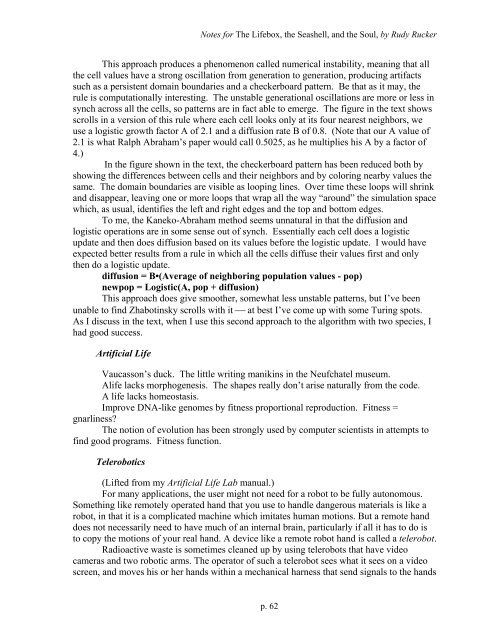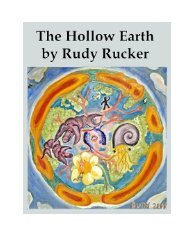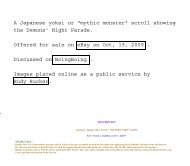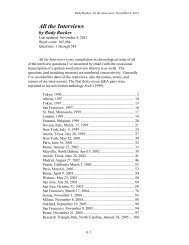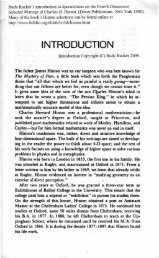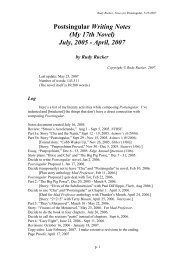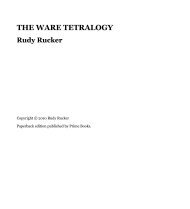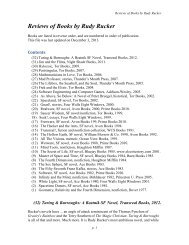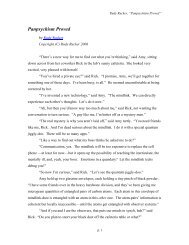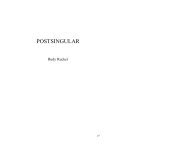Notes for the Lifebox, the Seashell, and the Soul - Rudy Rucker
Notes for the Lifebox, the Seashell, and the Soul - Rudy Rucker
Notes for the Lifebox, the Seashell, and the Soul - Rudy Rucker
You also want an ePaper? Increase the reach of your titles
YUMPU automatically turns print PDFs into web optimized ePapers that Google loves.
<strong>Notes</strong> <strong>for</strong> The <strong>Lifebox</strong>, <strong>the</strong> <strong>Seashell</strong>, <strong>and</strong> <strong>the</strong> <strong>Soul</strong>, by <strong>Rudy</strong> <strong>Rucker</strong><br />
This approach produces a phenomenon called numerical instability, meaning that all<br />
<strong>the</strong> cell values have a strong oscillation from generation to generation, producing artifacts<br />
such as a persistent domain boundaries <strong>and</strong> a checkerboard pattern. Be that as it may, <strong>the</strong><br />
rule is computationally interesting. The unstable generational oscillations are more or less in<br />
synch across all <strong>the</strong> cells, so patterns are in fact able to emerge. The figure in <strong>the</strong> text shows<br />
scrolls in a version of this rule where each cell looks only at its four nearest neighbors, we<br />
use a logistic growth factor A of 2.1 <strong>and</strong> a diffusion rate B of 0.8. (Note that our A value of<br />
2.1 is what Ralph Abraham’s paper would call 0.5025, as he multiplies his A by a factor of<br />
4.)<br />
In <strong>the</strong> figure shown in <strong>the</strong> text, <strong>the</strong> checkerboard pattern has been reduced both by<br />
showing <strong>the</strong> differences between cells <strong>and</strong> <strong>the</strong>ir neighbors <strong>and</strong> by coloring nearby values <strong>the</strong><br />
same. The domain boundaries are visible as looping lines. Over time <strong>the</strong>se loops will shrink<br />
<strong>and</strong> disappear, leaving one or more loops that wrap all <strong>the</strong> way “around” <strong>the</strong> simulation space<br />
which, as usual, identifies <strong>the</strong> left <strong>and</strong> right edges <strong>and</strong> <strong>the</strong> top <strong>and</strong> bottom edges.<br />
To me, <strong>the</strong> Kaneko-Abraham method seems unnatural in that <strong>the</strong> diffusion <strong>and</strong><br />
logistic operations are in some sense out of synch. Essentially each cell does a logistic<br />
update <strong>and</strong> <strong>the</strong>n does diffusion based on its values be<strong>for</strong>e <strong>the</strong> logistic update. I would have<br />
expected better results from a rule in which all <strong>the</strong> cells diffuse <strong>the</strong>ir values first <strong>and</strong> only<br />
<strong>the</strong>n do a logistic update.<br />
diffusion = B•(Average of neighboring population values - pop)<br />
newpop = Logistic(A, pop + diffusion)<br />
This approach does give smoo<strong>the</strong>r, somewhat less unstable patterns, but I’ve been<br />
unable to find Zhabotinsky scrolls with it ⎯ at best I’ve come up with some Turing spots.<br />
As I discuss in <strong>the</strong> text, when I use this second approach to <strong>the</strong> algorithm with two species, I<br />
had good success.<br />
Artificial Life<br />
Vaucasson’s duck. The little writing manikins in <strong>the</strong> Neufchatel museum.<br />
Alife lacks morphogenesis. The shapes really don’t arise naturally from <strong>the</strong> code.<br />
A life lacks homeostasis.<br />
Improve DNA-like genomes by fitness proportional reproduction. Fitness =<br />
gnarliness?<br />
The notion of evolution has been strongly used by computer scientists in attempts to<br />
find good programs. Fitness function.<br />
Telerobotics<br />
(Lifted from my Artificial Life Lab manual.)<br />
For many applications, <strong>the</strong> user might not need <strong>for</strong> a robot to be fully autonomous.<br />
Something like remotely operated h<strong>and</strong> that you use to h<strong>and</strong>le dangerous materials is like a<br />
robot, in that it is a complicated machine which imitates human motions. But a remote h<strong>and</strong><br />
does not necessarily need to have much of an internal brain, particularly if all it has to do is<br />
to copy <strong>the</strong> motions of your real h<strong>and</strong>. A device like a remote robot h<strong>and</strong> is called a telerobot.<br />
Radioactive waste is sometimes cleaned up by using telerobots that have video<br />
cameras <strong>and</strong> two robotic arms. The operator of such a telerobot sees what it sees on a video<br />
screen, <strong>and</strong> moves his or her h<strong>and</strong>s within a mechanical harness that send signals to <strong>the</strong> h<strong>and</strong>s<br />
p. 62


